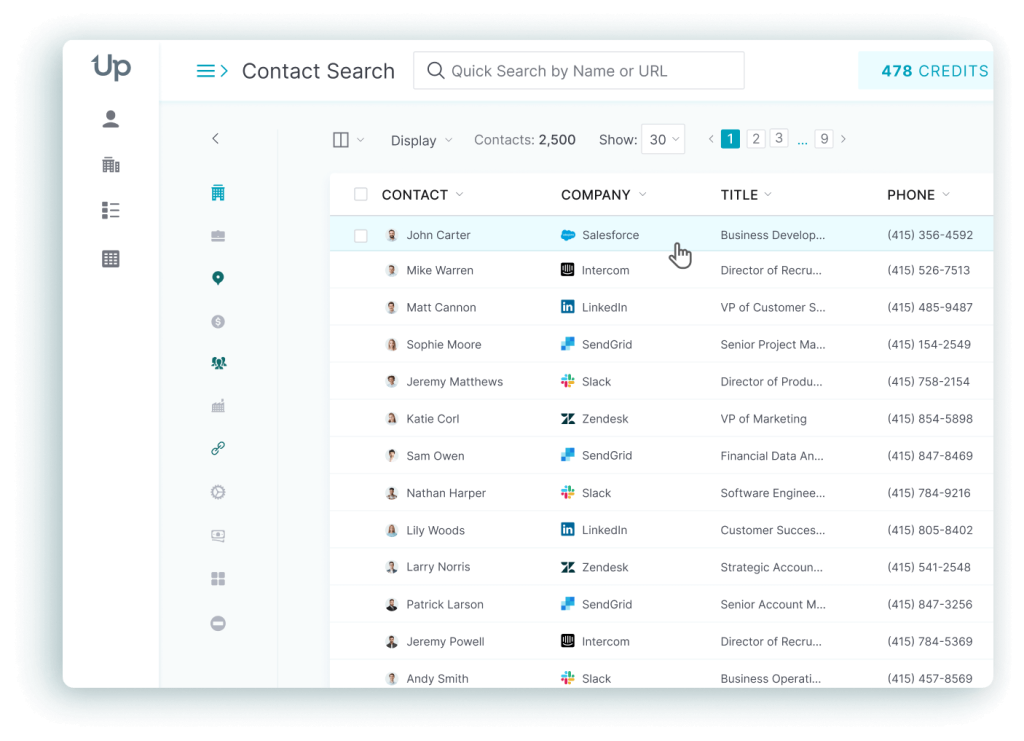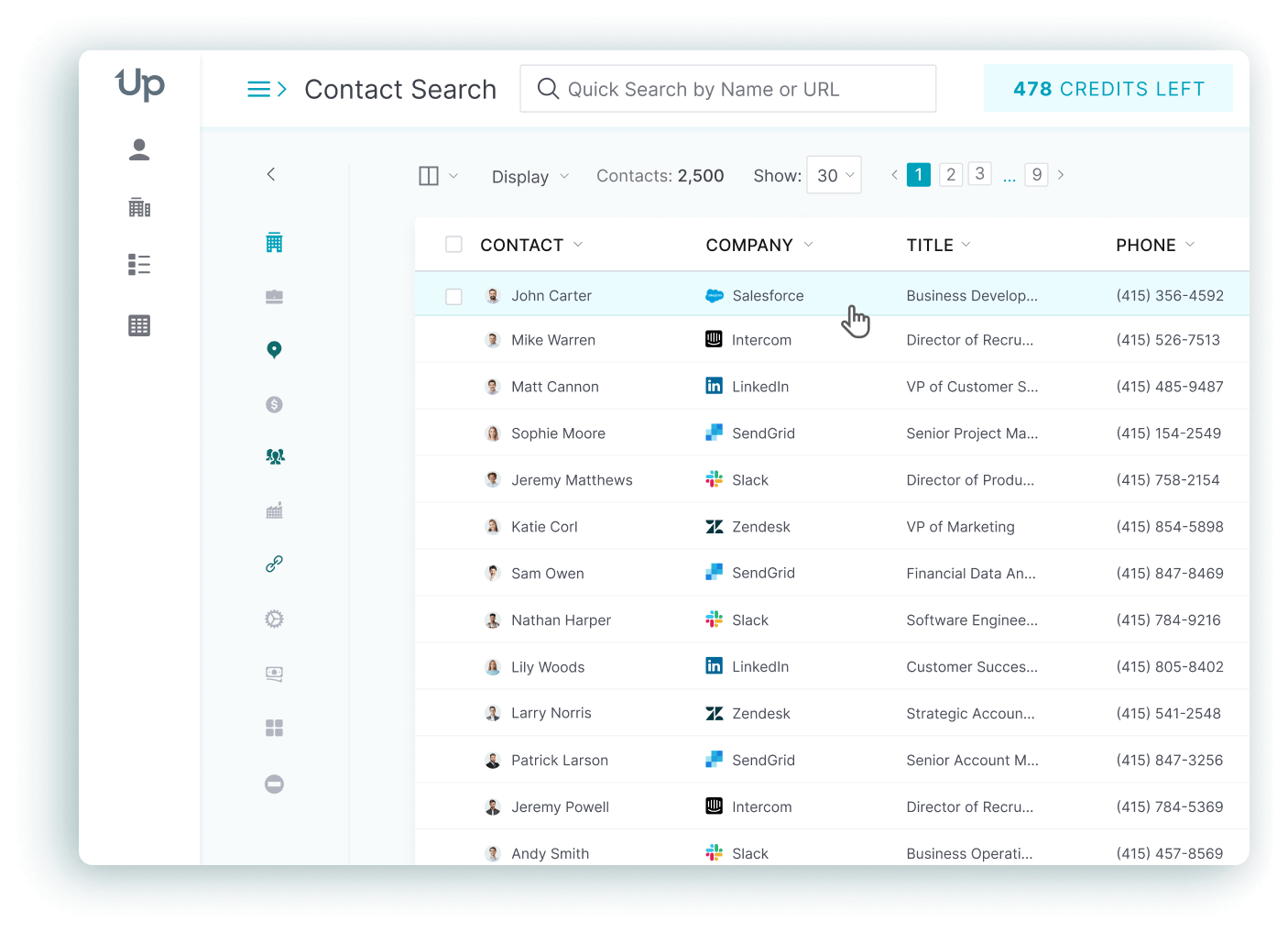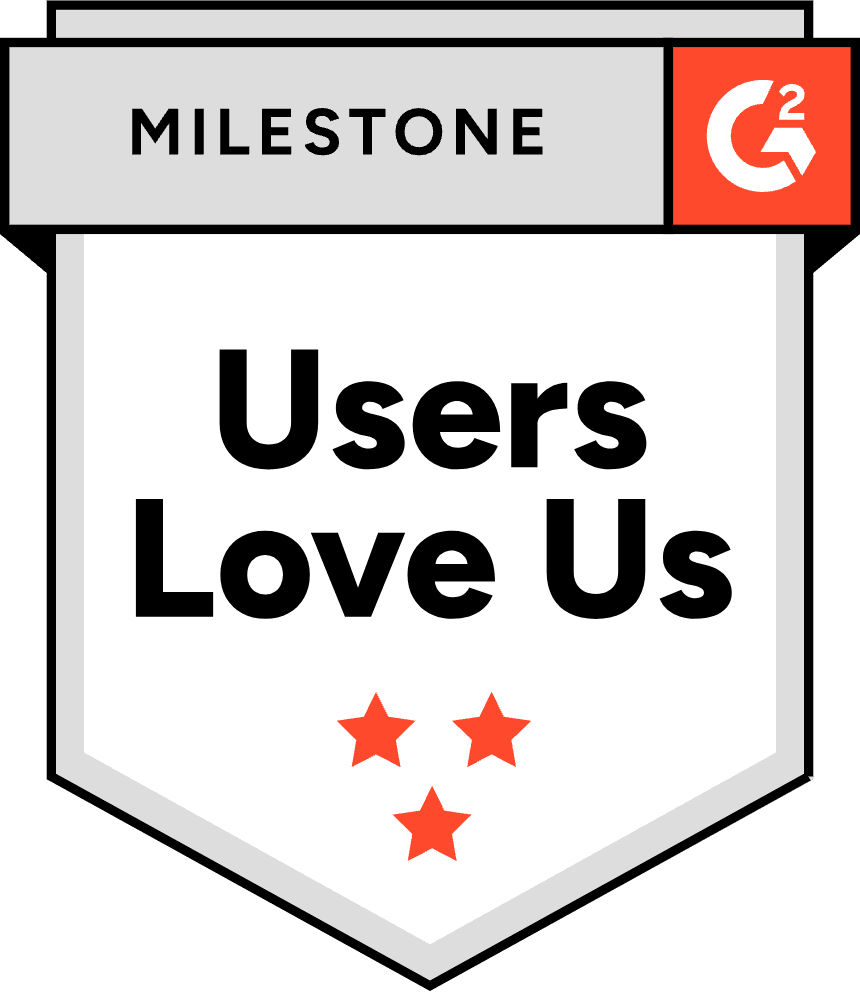You’ve found the perfect prospect but you can’t reach them.
Email is the most effective B2B channel, yet decision-makers’ contact information is rarely public.
Hours spent piecing together LinkedIn profiles and guessing email formats lead nowhere. Messages bounce or vanish into unmonitored inboxes.
Finding accurate employee emails doesn’t require guesswork.
The right methods get you verified contacts efficiently and ethically.
This guide ranks 12 proven methods for finding company employee emails, scoring each on accuracy and simplicity. You’ll get actionable strategies to find verified contacts while staying compliant with GDPR and CAN-SPAM regulations.
What are the most effective ways to find company employees’ emails?
Now, there are several ways to find company employees’ emails. But it all comes down to getting accurate emails and how simple they are to use. Regarding accuracy and simplicity, B2B email finder tools are the best way by far, even this year. You need to just pay a subscription and you’ll get access to a large database full of accurate emails of the person you require.
There are also tons of other ways such as buying an email list, checking out the company’s website, attending webinars, or scrolling through LinkedIn. Even though these free options won’t cost you a penny, they might take more time than you realize and may not be accurate.
To make it easy for you, we’ll now compare 10 methods to find emails and rank them based on their accuracy and simplicity of use.

Get Verified Employee Emails Instantly
160M+ profiles · 95% accuracy · 50+ filters
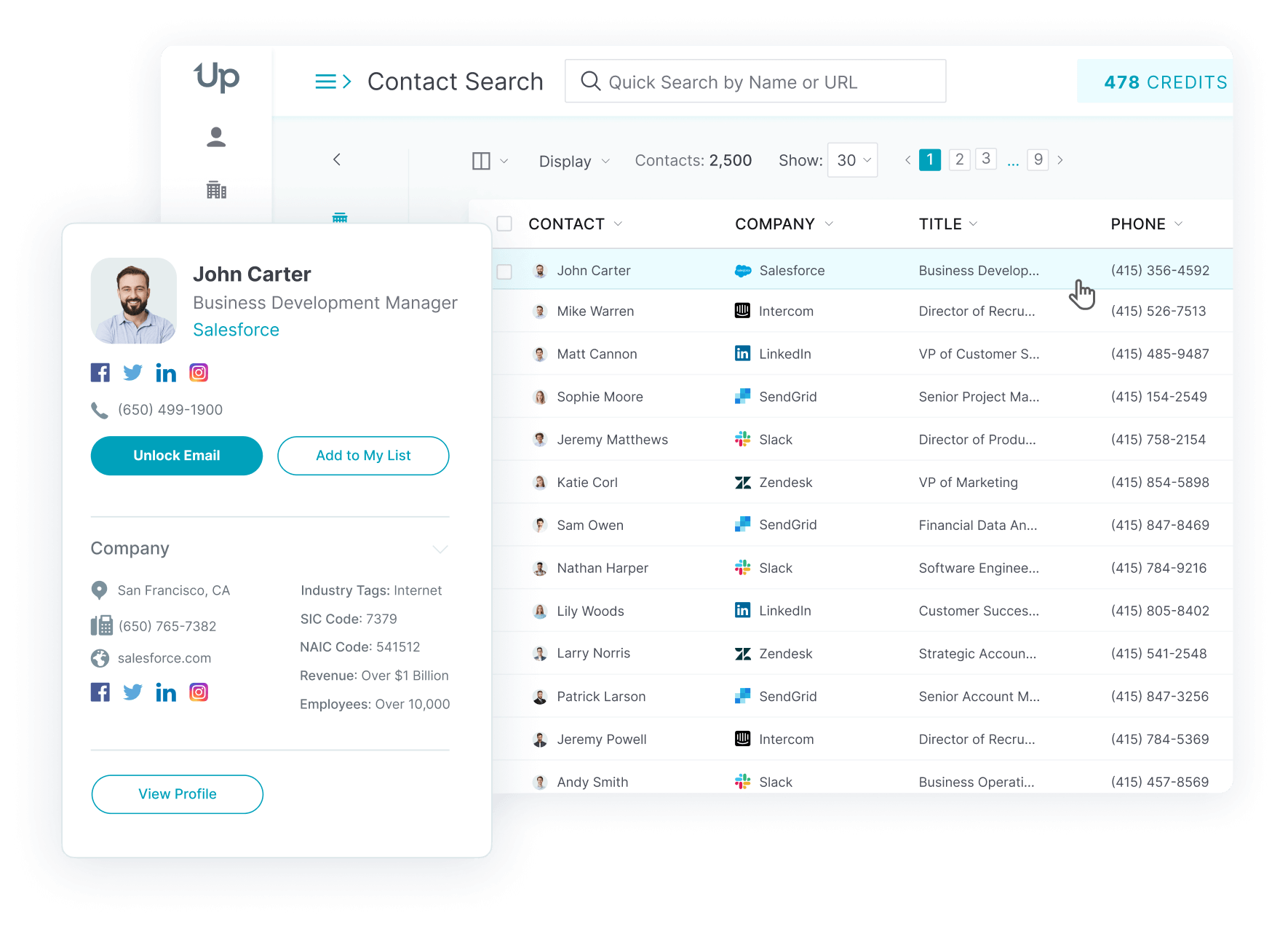
Use B2B Email Finder Tools
As mentioned before, when it comes to efficiency, B2B email finder tools rank at the top. They have huge databases with tons of contact information and employee email addresses of the company’s top decision-makers and company employees, which can save you hours of manual search time.
There are plenty of email lookup tools available in the market, such as UpLead, Hunter.io, SignalHire, etc.
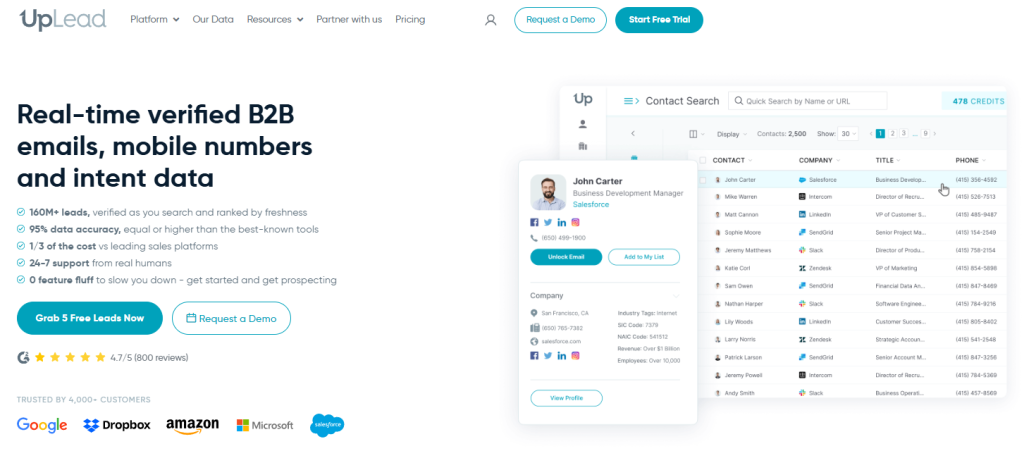
Each differs based on its price, features, and modus operandi. These email verification services provide high quality data to help you find company email addresses and connect with your ideal customer profile.
How to get started:
- Sign up for a tool like UpLead
- Enter the company name or employee name into the search bar
- Use filters like location or industry to narrow your results
- Within seconds, Uplead will provide you with verified emails of the employee or company along with other relevant contact details.
Accuracy: 9/10
Simplicity: 8/10
Email Finding Score: 17/20 (Accuracy + Simplicity)
Buy an Email List
Next on the list is buying an email list. It’s a straightforward method where you go directly to the source and buy a pre-made list of employees with bulk contact information across different companies. Even though you get access to tons of information in an instant, there is a chance that some of these email addresses might be outdated or illegal. Many business directories offer email lists, but ensure they provide accurate emails and follow data protection regulations.
How to get started:
You can buy email lists from services like UpLead, Zoominfo, or Datarade. Make sure the provider follows GDPR compliance and has access to clean data. To get email lists from UpLead:
- Sign up for an account in UpLead
- Click on the Email list feature to search for email lists
- Enter company name or industry name
- UpLead will generate the best email lists and other relevant information for you.

Accuracy: 8/10
Simplicity: 8/10
Email Finding Score: 16/20 (Accuracy + Simplicity)
Check Company Websites (Homepage, About Us, Privacy Policy …)
Sometimes, the most obvious method to find company emails is to just look at the lead’s website. Many companies list the contact details of their top executives on their website, especially on the Homepage, About Us page, and Privacy Policy.
Sometimes, you may get generic emails like [email protected] or [email protected], but it’s a good place to get started. Visit the company domain and search through their pages to find email addresses.
How to get started:
- Visit the company’s website
- Search through the website to find relevant emails, especially on the Homepage, About Us, Privacy Policy, etc.
- Some websites may have an employee directory or a management page where you can look for more information
Accuracy: 8/10
Simplicity: 7/10
Email Finding Score: 15/20 (Accuracy + Simplicity)
Search via Professional Networking Sites such as LinkedIn
You can also use professional networking sites like LinkedIn to find email addresses. It’s the best way to find the email addresses of top executives like CEOs.
Even though it doesn’t directly display your prospects’ email addresses, you can pair it with other tools or request their email to get the relevant information.
LinkedIn is particularly helpful for finding marketing manager contact details and other key decision-makers.
How to get started:
- Use LinkedIn Sales Navigator for in-depth searches of your prospect.
- You can also connect with the prospect or send an Inmail to ask for their emails
- Use third-party email finder tools that integrate with Linkedin, like Lusha or SignalHire.
- Once you’ve found your prospect, open the email finder tool that pops up as an extension or copy-paste the profile URL to the search bar.
- Within seconds, you can get your prospect’s verified email.

Accuracy: 7/10
Simplicity: 6/10
Email Finding Score: 13/20 (Accuracy + Simplicity)
Leverage Social Media Platforms
Surprisingly, social media platforms are also helpful in getting you company employees’ emails. Platforms like Twitter, Instagram, and Meta may contain opportunities to find contact information.
Some professionals may leave their emails in their bio for networking purposes or as links to their websites. You can also do in-depth searches of their profile to find whether they have dropped their email in any post or comment. This method can help you connect with users and find employee emails for cold outreach.
How to get started:
- Search for the profile and verify whether they have an email on their profile
- If it’s not visible, try looking for a personal website link
- You can also use advanced search features on platforms like Twitter to find tweets or posts that include an email address.
Accuracy: 5/10
Simplicity: 7/10
Email Finding Score: 12/20 (Accuracy + Simplicity)
Attend Webinars and Networking Events
You can also attend webinars and networking events to find emails or contact info for the speaker. Many professionals share their emails after the event or send emails to the participants regarding the event. This is an excellent way to get emails without much work from your side and helps you connect with potential customers in your target organization.
How to get started:
- Sign up for a webinar or a networking event
- Look for the email addresses of the speaker or the organizing company whom you can contact to get the emails
- Check for Q&A sessions where the speaker will most likely give out their contact info.
Accuracy: 6/10
Simplicity: 6/10
Email Finding Score: 12/20 (Accuracy + Simplicity)
Use Company Databases and Directories
Company directories and databases are excellent sources to find information about the company and its employees. Tools like Crunchbase and Zoominfo are popular for finding information on companies and employees in a database format. These business directories provide comprehensive contact details and help you identify the right person within an organization.
How to get started:
- Sign up for a company directory like Zoominfo
- Filter by company name or industry to view a list of employees
- Look through the information to find titles, contact details, and sometimes direct emails
Accuracy: 7/10
Simplicity: 8/10
Email Finding Score: 15/20 (Accuracy + Simplicity)
Perform Advanced Google Search Techniques
Google is also an excellent way to find email addresses through search queries. Google indexes tons of web pages every second, so it may also index email addresses that may not be immediately visible on websites. Google has some advanced search operations that you can use to filter and narrow down your search. This process can help you find company email addresses across various pages and sites.
How to get started:
To search by name and domain – “First_name last_name” AND “@companydomain.com”
To search by name and role – “First_name last_name” AND “marketing manager” AND “@companydomain.com”
To search by email pattern – “[email protected]“
To search for emails across specific websites – site:linkedin.com “@companydomain.com”
To search using filetypes – filetype:pdf “@companydomain.com”
There are more than these advanced search techniques you can use to narrow down your results and get the right results. You can mix and match with these operators and other tools to speed up the process.

Accuracy: 7/10
Simplicity: 3/10
Email Finding Score: 10/20 (Accuracy + Simplicity)
Ask for Referrals or Introductions
Sometimes, all you need to do is ask for a referral. If you have a strong network, ask for a mutual connection to introduce you to your prospect. This approach can help you connect with the right person and access their contact details through trusted relationships.
How to get started:
- Ask your mutual connection via mail or LinkedIn for a referral to your prospect
- Offer value to your mutual connection as well for mutual benefits.
Accuracy: 8/10
Simplicity: 6/10
Email Finding Score: 14/20 (Accuracy + Simplicity)
Subscribe to Company Newsletters
You can also subscribe to company newsletters to get emails. Many companies send their direct contact info via email to subscribers. Even though it doesn’t require any work from your side, it might take some time to get the emails with the actual contact info and your inbox might be filled with marketing emails from tons of companies. This method can help you identify key team members who send emails on behalf of the organization.
How to get started:
- Sign up for newsletters of companies you are interested in
- If the newsletters are sent from a specific person in the company, like the CXO or marketing manager, use the listed email to send your message.
Accuracy: 4/10
Simplicity: 7/10
Email Finding Score: 11/20 (Accuracy + Simplicity)
Try to Guess the Email Format
Sometimes, the easiest approach is just to guess the email format. Many companies use standard email formats for employee emails, such as [email protected] or [email protected]. You can mix and match and try guessing several email formats to find out which one’s right. This method works well when you know the employee name and company domain.
How to get started:
- Look at the company’s website to find its domain (e.g., @company.com).
- Find out the employer’s/decision maker’s first name and last name
Use the employee’s name and plug it into commonly used email structures like:
[email protected] (e.g., [email protected])
[email protected] (e.g., [email protected])
[email protected] (e.g., [email protected])
- Verify these emails with email verification tools before sending them to make sure they are reliable.
Accuracy: 5/10
Simplicity: 7/10
Email Finding Score: 12/20 (Accuracy + Simplicity)
Use Email Finder Chrome Extensions
Email finder Chrome extensions provide a seamless workflow for finding employee email addresses directly from your browser. These tools integrate with LinkedIn, company websites, and other platforms to help you find email addresses without switching between different tools. Many offer a free plan with limited searches, making them accessible for small-scale prospecting.
How to get started:
- Install an email finder extension like Hunter, Lusha, or UpLead from the Chrome Web Store
- Visit a LinkedIn profile or company website
- Click the extension icon to reveal available email addresses
- Export the data to Google Sheets or your CRM for further use
Accuracy: 7/10
Simplicity: 9/10
Email Finding Score: 16/20 (Accuracy + Simplicity)
Leverage Google Workspace and Gmail Integration
Many email finder tools integrate directly with Google Workspace and Gmail, allowing you to find and verify email addresses without leaving your inbox. This integration creates a seamless workflow for cold outreach campaigns and helps you maintain all communication in one place. You can send emails directly from Gmail while ensuring compliance with data protection regulations.
How to get started:
- Install an email finder tool that integrates with Gmail
- Search for prospects directly from your Gmail interface
- Verify email addresses before sending cold emails
- Track email opens and responses within your Gmail inbox
Accuracy: 8/10
Simplicity: 8/10
Email Finding Score: 16/20 (Accuracy + Simplicity)
How do I ensure the ethical use of found emails?
Some might be concerned about whether finding these emails is legal and how to use them ethically. To avoid any legal action and ethically use these found emails, make sure you are fully transparent and ask for their consent. When reaching out, clearly state your purpose and provide value to your recipient. Always protect personal data and ensure you have permission before adding contacts to your email lists.
Also, don’t send spammy messages or marketing emails without their permission. If they ask to remove you from their list, apologize and avoid sending any messages or keeping that email with you. Always include an unsubscribe option in your marketing emails and respect the recipient’s communication preferences.
You must also ensure compliance with anti-spam laws and data protection regulations to avoid misuse of the information and to stay on the right side of the law. This includes following GDPR guidelines when dealing with EU customers and CAN-SPAM requirements for US recipients.
How can I ensure compliance while searching for emails?
To ensure compliance while searching for emails, consider regulations like the GDPR Act for EU citizens and the CAN-SPAM Act for the US. These laws require you to get consent from the recipient before you can send out marketing emails. Always verify that your email finder tools follow these data protection regulations and provide accurate emails from legitimate sources.
You must also avoid illegal means of getting emails, such as scraping sites without permission or using lists from the dark web. If you are planning to use an email finder tool, always opt for one that is trustworthy and offers verified, compliant data. Look for tools that provide details about their data sources and verification process.
Also, ensure that you have a legitimate interest in the recipient and that your practices align with regional privacy laws. When you send emails, always identify yourself clearly, provide value in your message, and include easy opt-out options for recipients.
What are the best practices for email verification?
Email verification is crucial for maintaining a good sender reputation and ensuring your cold emails reach the intended recipient. The best practice is to verify email addresses before adding them to your email lists or sending any outreach messages. This process helps you avoid bounces, protect your domain reputation, and improve your overall email deliverability rates.
Most email verification services check for syntax errors, domain validity, and mailbox existence. Some advanced tools also detect spam traps, role-based emails, and disposable email addresses. When choosing an email verification service, look for real-time verification capabilities and high accuracy rates to ensure the best results for your cold outreach campaigns.
How do email formats vary across different industries and company sizes?
Email formats can vary significantly across different industries and company sizes. Large corporations often use standardized formats like [email protected], while smaller companies might use simpler formats like [email protected]. Tech companies frequently use first initial + lastname formats, while traditional industries might prefer more formal structures.
Understanding these patterns can help you guess email formats more accurately when using manual methods. However, the most reliable approach is to use email finder tools that can identify the specific format used by each organization. Some tools even provide format patterns for entire domains, making it easier to find multiple contacts within the same company.
FAQs
Yes, finding company employee emails is legal, but you must follow privacy laws such as GDPR for EU citizens and CAN-SPAM for the US. These laws regulate the emails you collect and ensure that you use them with the users’ consent.
Yes, you can verify emails using tools like NeverBounce or Hunter.io. These services check whether an email address is active and can receive messages. You can also try sending a round of test emails to the emails you found to verify validity.
Different methods have different accuracy rates depending on their reliability and source of information. B2B email finder tools like UpLead or Hunter.io are highly accurate and offer verified emails while other methods, such as guessing email formats or using advanced Google search, may be less reliable and require further verification.
You can use email verification services like ZeroBounce, NeverBounce, or Hunter.io to ensure the email is valid and deliverable.
Yes, you can find company emails for free using advanced Google search operations or manually searching the company’s website or social media platforms for any links to email addresses. However, these methods may consume much time and not provide accurate information.
Yes, social media platforms like LinkedIn and Twitter can effectively find email addresses. Employees often list their contact information in their bios or posts. Still, this method is not always guaranteed to provide accurate emails so verify these emails before sending your material right away.
Most companies stick to a standard email format like [email protected]. However, there are chances that a company might change their email often due to new policies so it’s always a good idea to verify the email format using email verification tools.
Yes, most email lookup tools, such as UpLead, Lusha, and Hunter.io, are accessible globally. However, be mindful of regional laws that regulate how emails can be collected and used in different regions.
The best email finder tools include UpLead, Hunter.io, Apollo.io, and RocketReach. UpLead stands out for its high accuracy rates and real-time verification, while Hunter.io offers good domain search capabilities. Choose based on your specific needs for database size, accuracy, and integration options.
You can find email addresses in bulk using B2B email finder tools like UpLead or Apollo.io. These platforms allow you to search by company name, industry, or job title and export large lists of verified email addresses. Many tools also offer API access for automated bulk email finding and can integrate with Google Sheets for easy data management.
Effective cold emails should include personalization (mention the recipient’s name and company), a clear value proposition, social proof or credibility indicators, and a specific call-to-action. Keep the message concise, avoid spam triggers, and always provide an easy way for recipients to opt out. Follow up strategically but respect their communication preferences.
Protect your sender reputation by always verifying email addresses before sending, maintaining low bounce rates, avoiding spam triggers in your content, and including clear unsubscribe options. Use email verification services, warm up new domains gradually, and monitor your deliverability metrics. Never buy email lists from unreliable sources or send unsolicited marketing emails without proper consent.
